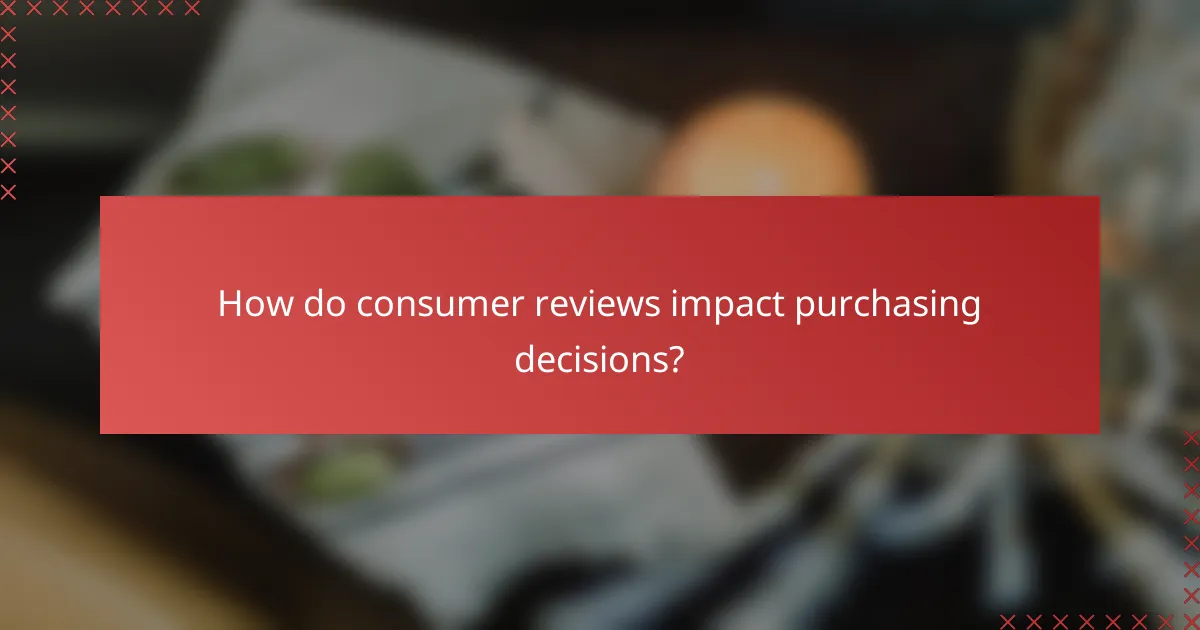Consumer reviews play a crucial role in shaping purchasing decisions, as they can significantly influence perceptions of products and services. By examining key factors such as product quality, customer service, and price competitiveness, businesses can gain valuable insights to enhance customer satisfaction and improve their offerings.

How do consumer reviews impact purchasing decisions?
Consumer reviews significantly influence purchasing decisions by shaping perceptions of products and services. Positive feedback can lead to increased sales, while negative reviews can deter potential buyers.
Influence on buyer behavior
Consumer reviews play a crucial role in shaping buyer behavior by providing insights into product quality and user experience. Many shoppers rely on reviews to validate their choices, often considering them as important as personal recommendations.
Research indicates that a majority of consumers read multiple reviews before making a purchase, with many prioritizing recent feedback. This trend highlights the importance of maintaining a steady flow of positive reviews to attract new customers.
Trust-building through reviews
Trust is a key factor in online shopping, and consumer reviews are instrumental in building that trust. Authentic reviews from real users can enhance credibility, making potential buyers feel more secure in their purchasing decisions.
Brands that actively engage with reviews, whether positive or negative, demonstrate transparency and a commitment to customer satisfaction. This engagement can further strengthen trust and encourage repeat business.
Impact on brand reputation
Consumer reviews directly affect a brand’s reputation, influencing how it is perceived in the market. A collection of positive reviews can elevate a brand’s status, while a series of negative comments can lead to lasting damage.
Brands should monitor their reviews regularly and address any issues promptly. Implementing a strategy for soliciting feedback can help maintain a positive reputation and mitigate the impact of negative reviews.

What are the key factors influencing consumer reviews?
Key factors influencing consumer reviews include product quality, customer service experience, and price competitiveness. Understanding these elements can help businesses improve their offerings and enhance customer satisfaction.
Product quality
Product quality is often the most significant factor in consumer reviews. High-quality products tend to receive positive feedback, while subpar items can lead to negative experiences. Consumers typically evaluate quality based on durability, performance, and reliability.
To ensure high product quality, businesses should implement rigorous testing and quality control measures. Gathering feedback from initial users can also provide insights into potential improvements before a wider release.
Customer service experience
The customer service experience plays a crucial role in shaping consumer reviews. Prompt, helpful, and friendly service can turn a mediocre product experience into a positive review. Conversely, poor customer service can overshadow even the best products.
Companies should train staff to handle inquiries and complaints effectively. Offering multiple channels for support, such as phone, email, and live chat, can enhance the overall customer experience and encourage positive feedback.
Price competitiveness
Price competitiveness is another key factor that influences consumer reviews. Customers often compare prices across different brands and retailers, seeking the best value for their money. A product priced too high may deter potential buyers, while a competitive price can attract more positive reviews.
To maintain price competitiveness, businesses should regularly analyze market trends and adjust pricing strategies accordingly. Offering promotions or discounts can also incentivize purchases and lead to favorable reviews.

How to analyze consumer reviews effectively?
To analyze consumer reviews effectively, focus on understanding the sentiments expressed, identifying patterns, and extracting actionable insights. This involves using various tools and metrics to interpret the data meaningfully and make informed decisions.
Sentiment analysis tools
Sentiment analysis tools help determine the emotional tone behind consumer reviews. These tools use natural language processing (NLP) to classify reviews as positive, negative, or neutral, allowing businesses to gauge overall customer satisfaction. Popular tools include Google Cloud Natural Language, IBM Watson, and various open-source options.
When selecting a sentiment analysis tool, consider its accuracy, ease of integration, and the languages it supports. Some tools may offer additional features like trend analysis or keyword extraction, which can provide deeper insights into consumer opinions.
Review aggregation platforms
Review aggregation platforms compile reviews from multiple sources, giving a comprehensive view of consumer feedback. Websites like Trustpilot, Yelp, and Google Reviews allow businesses to monitor their reputation and respond to customer concerns effectively. These platforms often provide analytics tools to track performance over time.
Utilizing review aggregation platforms can streamline the process of gathering feedback. Look for platforms that offer customizable reporting features, enabling you to focus on specific metrics that matter most to your business.
Key metrics to track
When analyzing consumer reviews, key metrics to track include overall rating, review volume, sentiment score, and response rate. The overall rating provides a quick snapshot of customer satisfaction, while review volume indicates how engaged customers are with your product or service.
Additionally, monitoring sentiment scores helps identify shifts in consumer perception over time. Aim for a response rate of at least 30% to show customers that their feedback is valued, which can enhance loyalty and trust.

What trends are shaping consumer reviews in e-commerce?
Consumer reviews in e-commerce are increasingly influenced by technology and changing consumer expectations. Key trends include the rise of video reviews, the impact of social media, and a shift towards more authentic feedback.
Rise of video reviews
Video reviews are becoming a dominant format in consumer feedback, as they provide a more engaging and informative way to showcase products. Shoppers often prefer seeing products in action rather than just reading text, leading to higher conversion rates.
Brands can leverage video reviews by encouraging customers to share their experiences on platforms like YouTube or Instagram. This not only enhances credibility but also allows potential buyers to visualize the product’s use in real-life scenarios.
Impact of social media on reviews
Social media platforms significantly influence consumer reviews, as users frequently share their opinions and experiences with products online. Positive or negative feedback can spread rapidly, affecting brand reputation and sales.
Businesses should actively monitor social media for reviews and engage with customers to address concerns or amplify positive feedback. This interaction can foster trust and loyalty among consumers, making it essential for brands to maintain a strong social media presence.
Shift towards authentic feedback
There is a growing demand for authentic and honest reviews, as consumers become more discerning about the information they trust. Shoppers are increasingly skeptical of overly polished testimonials and prefer genuine experiences shared by real users.
To adapt, brands should encourage honest feedback from customers and highlight both positive and negative reviews. This transparency can enhance credibility and help potential buyers make informed decisions, ultimately benefiting the brand’s reputation.

How to encourage more consumer reviews?
Encouraging more consumer reviews involves creating an environment where customers feel motivated to share their experiences. This can be achieved through incentives, streamlined processes, and effective follow-up communication.
Incentivizing feedback
Incentives can significantly boost the number of consumer reviews you receive. Offering discounts, loyalty points, or entries into a prize draw can motivate customers to provide their feedback. For instance, a 10% discount on their next purchase for leaving a review can be an effective strategy.
However, ensure that the incentives do not compromise the authenticity of the reviews. Transparency about the incentive and encouraging honest feedback is crucial to maintain credibility.
Creating a seamless review process
A seamless review process is essential for encouraging consumer participation. Simplifying the steps required to leave a review can lead to higher submission rates. Consider using user-friendly platforms that allow reviews to be submitted in just a few clicks.
Additionally, mobile optimization is key, as many consumers prefer to leave reviews on their smartphones. Providing clear instructions and minimizing the required fields can enhance the user experience.
Utilizing follow-up emails
Follow-up emails serve as a gentle reminder for customers to leave reviews after their purchase. Sending a personalized email a few days post-purchase can prompt customers to share their thoughts while the experience is still fresh in their minds.
Make sure the email is concise and includes a direct link to the review page. A well-timed follow-up can increase review rates significantly, often by 20-30% if executed properly.

What are the best practices for responding to consumer reviews?
Best practices for responding to consumer reviews include being prompt and engaging in a personalized manner. These strategies help build trust and demonstrate that you value customer feedback.
Timely responses
Responding to consumer reviews promptly is crucial. Aim to reply within a few days, as this shows that you prioritize customer opinions and are actively engaged with your audience. Timely responses can significantly enhance customer satisfaction and loyalty.
Consider setting up alerts for new reviews to ensure you don’t miss any feedback. A quick acknowledgment can go a long way, even if a full response takes longer to craft.
Personalized engagement
Personalizing your responses to consumer reviews can make a significant impact. Use the reviewer’s name and reference specific points they made to show that you genuinely care about their experience. This approach fosters a connection and encourages future interactions.
Avoid generic replies; instead, tailor your message to address the unique aspects of each review. For instance, if a customer mentions a specific product feature, acknowledge it and offer additional insights or assistance related to that feature.
